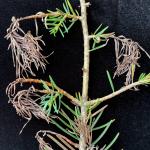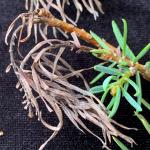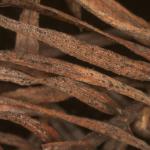Delphinella Shoot Blight
Pathogens
Delphinella shoot blight is caused by the fungal pathogens Delphinella abietis and D. balsamae. Delphinella balsamae is known to occur in eastern North America, while D. abietis occurs in western North America and Scandinavia (Talgø and Chastagner 2018, Waterman 1945).
Hosts & Distribution
True firs (Abies) are the primary host of Delphinella shoot blight and the disease appears to be somewhat uncommon in southern New England. Based on samples submitted to the UMass Plant Diagnostic Lab, white fir (Abies concolor) planted as ornamentals and Christmas trees is the most common host. This observation aligns with the findings by Waterman (1945), who described the pathogen (as Rehmiellopsis balsameae) from white fir in Maine, Massachusetts, New Hampshire, New York and Rhode Island. He also reported Delphinella from balsam fir (A. balsamea) in Maine, Fraser fir (A. fraseri) and noble fir (A. procera) in Massachusetts, and Greek fir (A. cephalonica) in Rhode Island.
Delphinella balsamae was later reported from white fir, balsam fir, and subalpine fir (A. lasiocarpa) in Vermont, with disease severity highest on subalpine fir (Merrill et al. 1997). In Quebec, D. balsamae can be regularly found on balsam fir grown as Christmas trees (Geurtin et al. 2019). In the western U.S., D. abietis has been reported causing significant damage on subalpine fir and noble fir grown as Christmas trees (Chastagner et al. 2017, Talgø and Chastagner 2018).
Symptoms & Signs
While the disease is uncommon in managed landscapes, outbreaks at Christmas tree farms can be serious. Infections develop early in the growing season before new growth is fully developed (Waterman 1945). Symptoms first appear in the lower canopy and then spreads upward. Infected treeswill have blighted shoot tips that are blackened and curled with dead needles that appear purple to brown in color (Talgø and Chastagner 2018, Waterman 1945). At times, the blighted shoot tips will curl downward (see photos). Using a hand lens or magnifying glass, the black-colored pseudothecia (spore-bearing structures) should be visible on the dead needles. Blighted needles are held in the canopy and provide the necessary inoculum to initiate new infections the following spring. Persistent wet and humid conditions in late spring and early summer are conducive to disease development and spread.
Management
Early detection in Christmas tree farms is important to reduce the risk of a damaging disease outbreak. If symptoms develop on one to a few trees, they should be immediately removed to reduce inoculum and limit spread of the pathogen. Controlling weeds and grasses growing around trees can also help to reduce disease incidence and severity. Dense vegetation allows moisture to linger and restricts air flow on lower canopy needles, where infections often first develop. For ornamental trees in managed landscapes, prune and discard the blighted shoot tips and remove this material from the site. Apply mulch or wood chips over discarded needles at the base of the tree. This will reduce inoculum used by the pathogen to initiate new infection centers the following year. Chemical application may be warranted when disease severity is high. Fungicide application should take place when new growth is ¼ elongated and on labeled intervals during the spring and early summer. Fungicides that may have some efficacy against the pathogen include: azoxystrobin, benzovindiflupyr, copper hydroxide, mancozeb, metconazole, phosphites, propiconazole, and thiophanate methyl. Drought stress often predisposes conifers to needle and shoot blight pathogens. Ensuring trees are well watered is important to maintain high vigor and promote natural defenses.
Citations
Chastagner GA, Riley K, Coats KP, Eikemo H, and Talgø V. 2017. Delphinella shoot blight and Grovesiella canker on Abies lasiocarpa in western USA. Scandinavian Journal of Forest Research 32(5): 432–437. https://doi.org/10.1080/02827581.2017.1317358
Guertin JF, Zitouni M, Tanguay P, Hogue R, and Beaulieu C. 2019. Detection of Delphinella shoot blight in plantations of balsam fir (Abies balsamea) Christmas trees in Quebec, Canada, Canadian Journal of Plant Pathology 41(1): 87–97. https://doi.org/10.1080/07060661.2018.1547791
Merrill W, Wenner NG, and Kelley, R. 1997. Delphinella balsameae tip blight of Abies lasiocarpa in Vermont. Plant Disease 81: 229. https://doi.org/10.1094/PDIS.1997.81.2.229C
Talgø V and Chastagner GA. 2018. Delphinella shoot blight on Christmas trees. Pp. 90–91 In Compendium of Conifer Diseases, 2nd edition. APS Press, St. Paul, MN.
Waterman AM. 1945. Tip blight of species of Abies caused by a new species of Rehmieilopsis. Journal of Agricultural Research 70(10): 315-337.



